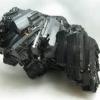-
Posts
66 -
Joined
-
Last visited
Other groups
Premier Members
 Year 14
Year 14

 Year 14
Year 14

About Lukas Exemplar
- Birthday 09/10/1994
Profile Information
-
Gender
Male
-
Location
Denmark
-
Interests
BIONICLE obviously, LEGO, writing fiction, reading fiction, art. Generally just fiction and media, especially the more fantastic genres, like science fiction, fantasy and science fantasy.
Contact Methods
-
Skype
lukassprehn
Recent Profile Visitors
1,290 profile views
Lukas Exemplar's Achievements

Turaga (7/293)
-

Reddish Gold Takanuva Armor Confirmed to Exist
Lukas Exemplar replied to Illuminatus's topic in Bionicle Discussion
Some LEGO instruction manuals have been spotty in the past and present when it comes to the color of pieces. Also, the image could be color-graded to look like that. Or it could be a CGI model rather than a photo - just a really well-made one, which had a slightly different color for whatever reason. But you're right, it is good evidence. -
Lukas Exemplar started following Suggestions and 2009
-
Lukas Exemplar started following blogs_blog_26
-
Lukas Exemplar started following Nuhrii the Metruan
-
Furst asked on social media if people wanted there to be any. Does not seem like anything a professional composer would ask if there wasn't some interest in the fandom. Maybe not a huge amount. We'll see... it would be interesting to see a movie or fantasy or sci-fi compilation concert to sneak in some of his music
-
Agreed!
-
I do not think it is going to truly die, and neither is the strong fandom. Not with all the great things that have happened in recent years, with all the huge fan projects and undertakings we've taken. The Doronai Nui RPG, BIONICLE: Masks of Power, the short-lived but very well-playing Mata Nui Online Game 3D, aka the fan sequel to MNOG 2, the discovery, release and continous work on, to update and fix, BIONICLE: The Legend of Mata Nui, the release of Nathan Furst's BIONICLE Miramax movie trilogy scores and the potential live concerts of them in the future. We're not dying, we're not going away. Unity, Duty, Destiny. And as one of the few of us remaining, I am one of the people hoping to see a continuation of specifically G1 one day. No matter what anyone says to me, that world need more... and that's why I joined many of the projects I listed above
-
Lukas Exemplar started following Branding the Elements , Just Two More , Change in Plan and 1 other
-
I still have no idea why they changed their website layout to such an ugly one. What is to be benefited from that?
-

IS BIONICLE RETURNING IN 2020?
Lukas Exemplar replied to LimeFlavouredLibertarian24's topic in Bionicle Discussion
4. Technically it would be the 21st anniversary, as the line already begun in 2000 in Europe, although many people don't count this year. -
It felt like it was already dead after the malicious attack it had years ago which put the site off for a year or so, and after we had to let go of the old archives when it had come back
-

Legend of Mata Nui Alpha Version Released
Lukas Exemplar replied to Hapori Tohu's topic in BZPower.com News Discussion
Holy , holy , holy . I am so excited. This is a an amazing time to be alive!!! -

Tapestry of Time [The Legend Continues]
Lukas Exemplar replied to Pomegranate's topic in General Art
In my opinion you deserved to win this. I am sorry that you did not. -

Full Toa Hagah Team With Custom 3D Printed Masks
Lukas Exemplar replied to 00dude00's topic in General Art
Awesome rendition dude. Here's another take on them, which you probably remember, since you were involved in the project where it stems from: Source: http://biosector01.com/wiki/index.php/User:Takatahu- 12 replies
-
Hello BZPers (is that really what we call ourselves?) This is going to get a little wee bit technical and scientific, and astrophysical, geological even. Sciency. I know the world of BIONICLE doesn't really have real world physics, but I was wondering anyway, does anyone think that Spherus Magna (and by extension, Bara Magna, Bota Magna and Aqua Magna) have/had plate tectonics? Today, in astrophysics, astronomy, geography and geology, it is thought that a planet needs plate tetconics in order to have life on them, for several reasons. One is it is indicative of active core inside the planet. And without an active core, you get no atmosphere, and by no atmosphere you get no oxygen, at least in the real universe. Another reason is that with the moving plates, and the constant recycling/reformation of the plates, all the stuff of life is replenished on our Earth. Things like large amounts of water and carbonate (the mineral form of Co2) is recycled back into the Earth as the plates move as well. I've gathered some text from articles on the subject. They are both a bit long, but hang in there please! I have something to say afterwards... Here is a bit of text taken from the article Plate Tectonics Could be Essential for Life at Astrobio.com Says Spohn, “plate tectonics replenishes the nutrition that primitive life could live on. Imagine a top surface that is depleted of the nutrition needed for bacterial life. It needs to be replenished, and plate tectonics is a method of achieving this.” Spohn found that the further he delved into the issue, the more important plate tectonics seemed to be for life. For example, it is believed that life developed by moving from the ocean to the kind of strong and stable rock formations that are the result of tectonic action. Plate tectonics is also involved in the generation of a magnetic field by convection of Earth’s partially molten core. This magnetic field protects life on Earth by deflecting the solar wind. Not only would an unimpeded solar wind erode our planet’s atmosphere, but it also carries highly energetic particles that could damage DNA. Another factor is the recycling of carbon, which is needed to stabilize the temperature here on Earth. Spohn explains, “plate tectonics is known to recycle carbon that is washed out of the atmosphere and digested by bacteria in the soil into the interior of the planet from where it can be outcast through volcanic activity. Now, if you have a planet without plate tectonics, you may have parts of this cycle, but it is broken because you do not have the recycling link.”<END OF QUOTATION> Another article, "Does a planet need plate tectonics to develop life?" from phys.org says about the movements of plates and habitable planets: Plate movements Plate tectonics provides a mechanism for this global thermostat. Most volcanism on the Earth occurs at plate boundaries in response to plate tectonics. And the most important volcanic products by mass – by a large amount – are two greenhouse gases: carbon dioxide and water. As they move over the Earth’s surface, some plates get recycled back into the mantle, at places like the Marianas Trench in the Pacific Ocean. Enormous amounts of water and carbonate (the mineral form of CO2) get recycled back into the interior as they do. Plate tectonics also form mountains, and one of the major sinks of CO2over geological time periods is weathering of mountains, where CO2dissolved in rainwater reacts with silicate minerals, forming new minerals, and drawing down atmospheric CO2 levels. In concert, these mechanisms act as a thermostat. If the Earth gets too hot, high levels of rainfall and erosion start bringing CO2 levels down. If the Earth gets too cold and freezes over, the erosion mechanism stops. But volcanism, due to plate tectonics, continues pumping CO2 into the atmosphere, and levels build up, eventually melting the icecaps. It was this mechanism that allowed Earth to recover from a global ice age in the Neoproterozoic, about 600 million years ago. Habitable planets This association between habitability, and plate tectonics, has become so entrenched that the search for habitable exosolar planets has focused on super earths. These are rocky planets larger than Earth where the odds for plate tectonics were thought to be higher. But the case is not so clear cut. Over the past decade, simulations of these super earths suggested that they may not have plate tectonics, but rather be in a stagnant-lid state, where a hot interior powers high levels of volcanism, but without moving plates. Our recent work has looked at the question from an evolutionary viewpoint. How do Earth-like planets evolve from their hot, violent beginnings to their eventual cool, quiescent twilights, radiating their last heat to space? We found that the evolutionary track a planet takes depends not only on its size, but on how it starts. For example, two planets identical in every other way, but with different starting temperatures, may evolve down very different evolutionary paths. We also found that plate tectonics may simply be a phase in the evolution of planets, and that planets may begin and end with stagnant lids.<END OF QUOTATION> Now, we do know that Spherus Magna had (or maybe have?) a core, which is, or was, comprised of Energized Protodermis. But do we know it acts like planet cores do in the real world? Earth's core generates heat, some of which is done through uranium in our core (yeah there's radioactive material in there), which by warming the adjacent molten material, rises to the earth's crust. This powers continental drift creates earthquakes and volcanoes, and mountains. But the movement of the molten iron of our world's core also creates magnetism, which protects the surface of the earth from the UV radiation coming from the sun. The fact that the core is semi-liquid is what makes the tectonics possible by the way. Now, the question is, does the core of Spherus Magna act like this too? Does SM even have an atmosphere? Wouldn't the 40,000,000 feet tall mechanoid the Great Beings built on there make that impossible? I mean, there is oxygen on there, or an equivalent, because beings, organic and biomechanical, have beem shown to have lungs. But an atmosphere would be needed to keep the oxygen in right? So is the atmosphere just super huge, reaching further out than Earth's? Or does the robot go through the atmosphere without any complications, like the atmosphere somehow breaking, if that's even possible to do by going through it, or being pierced constantly? And if plate tectonics does appear on Spherus Magna, what do you think the geography looked like in the past compared to the present? One last bit of speculation. When Aqua Magna and Bota Magna split from Spherus Magna, did they bring some of the Energized Protodermis with them, forming smaller cores of their own? It would seem like that would be necessary right? But again, real physics don't apply to BIONICLE, but it is still fun to theorize with the mindset that there are some kind of physical and scientific rules to all of it. Most of the best speculative fiction set in different worlds have its own rules and system, and follows them after all. I've found another article from Astrobio called "Earth’s Breathable Atmosphere Tied to Plate Tectonics?" It also has a bit about astrobiology later on, but I've only quoted the first two parts of the text below, The rise of oxygen is one of the biggest puzzles in Earth’s history. Our planet’s atmosphere started out oxygen-free. Then, around 3.5 billion years ago, tiny microbes called cyanobacteria (or blue-green algae) learned how to carry out photosynthesis. They began using energy from sunlight to make their food from carbon dioxide and water, giving off oxygen as waste. But it took another 3 billion years for oxygen levels to climb from trace amounts to at least 20 percent of the atmosphere, or high enough to support the emergence of complex life. And so far the mechanism behind that rise has remained unclear. Now a new study by University of Exeter biogeochemist Benjamin Mills and his colleagues offers a new potential clue. Using a computer model, they showed that plate tectonics may have fueled an increase in oxygen between 1.5 billion and half a billion years ago. In particular, a process tied to the way continents remove carbon dioxide from the atmosphere may have increased the supply of phosphorus, a key nutrient for photosynthetic microbes in the ocean. The paper was published this month in the Proceedings of the National Academy of Science. “This is a novel perspective for the late Proterozoic—a critical time of dramatic climate change, rising oxygen in the ocean and atmosphere, and origins and diversification of complex life,” says Timothy Lyons, a biogeochemist not involved in the study. From Seafloor to Terrestrial “Weathering’ The chemical weathering of rocks releases calcium ions in rivers and oceans, where they react with carbonate dissolved in the water. The product of that reaction, calcium carbonate, is then deposited onto the ocean floor, where it becomes limestone. (Photograph ©2009 Greg Carley.) Continents play a crucial role in the carbon cycle by removing carbon dioxide from the atmosphere. Carbon dioxide mixes with rain water, forming a weak acid (carbonic acid) which slowly wears down or “weathers” rocks on land. The process releases minerals such as calcium and magnesium from the rocks. These minerals then combine with carbonate and settle at the bottom of the ocean forming layers of calcium carbonate, or limestone. In other words, the weathering process simply pulls carbon from the atmosphere and turns it into a layer of sediment on the seafloor. However, continental rocks aren’t the only route by which carbon is removed from the atmosphere. Ocean ridges, the places where fresh crust is made on the seafloor, can undergo a similar “weathering” process. In fact, seafloor weathering was the main route of carbon removal in the early chapter of Earth’s history, before the formation of continents. According to the new study, the rise of oxygen may have been due to a shift in balance between the two processes—between seafloor and continental weathering. Also, bump ;P
-
The link to the tabs for Lhikan's Theme isn't working again.
-

Official My Little Pony topic
Lukas Exemplar replied to ~Allegretto~'s topic in Completely Off Topic
I guess no one really cares :'( Or maybe no one went to a convention he was at? I was asking whether anyone is going to go to one, not if they have been to one And he seems to appear at a lot of them, often with acting advice.- 7,768 replies
-
- My Little Pony
- Ponies
-
(and 1 more)
Tagged with:
-

Official My Little Pony topic
Lukas Exemplar replied to ~Allegretto~'s topic in Completely Off Topic
I guess no one really cares :'(- 7,768 replies
-
- My Little Pony
- Ponies
-
(and 1 more)
Tagged with:






